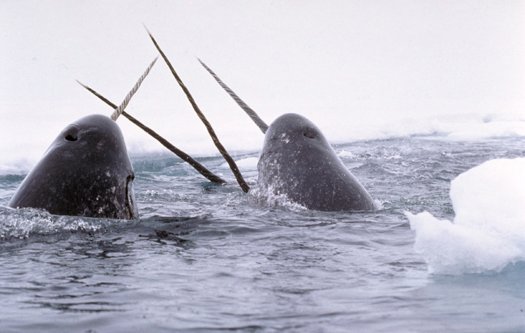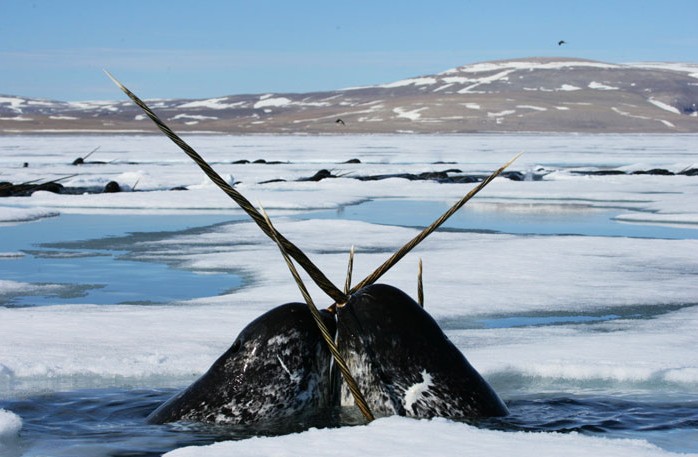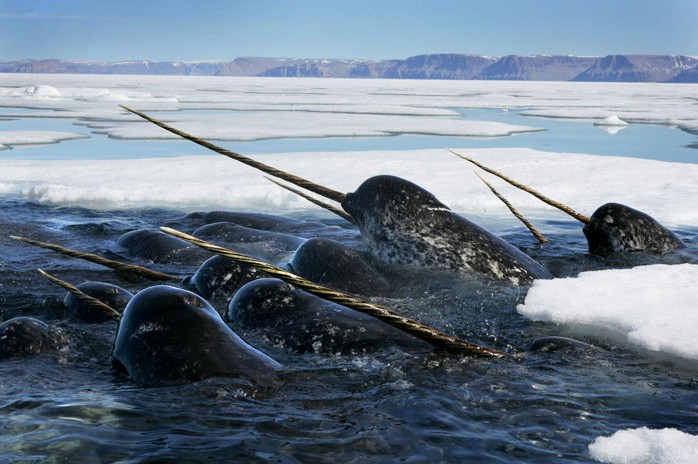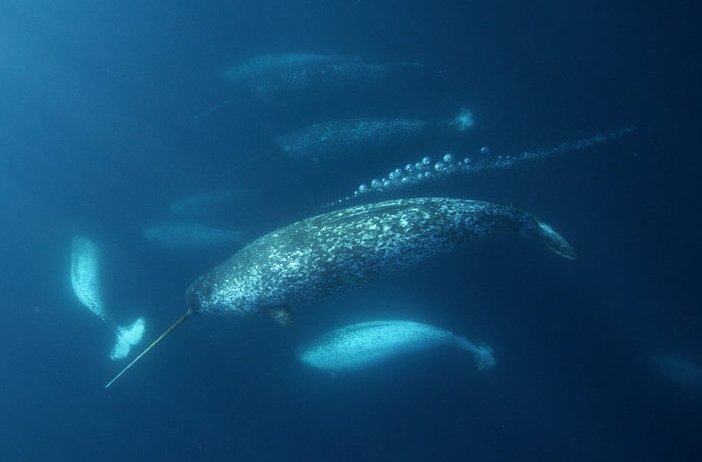Home page: www.treks.org
Table of Contents Arctic
Arctic Safari
You are visitor:
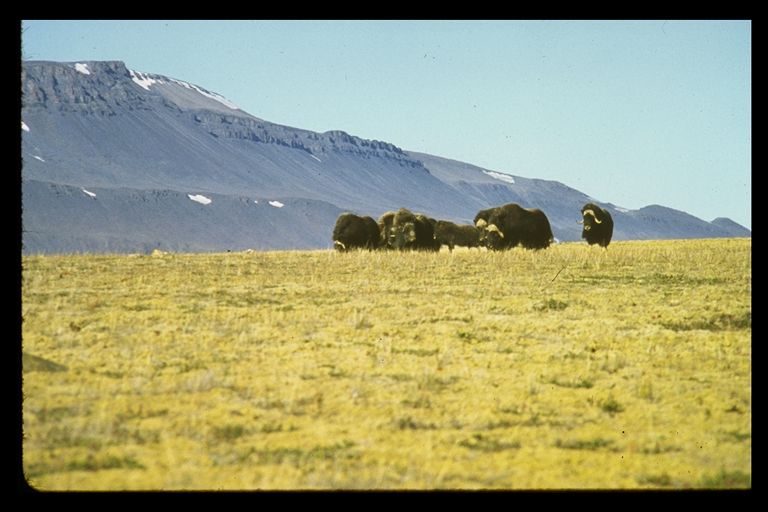
Muskox herd, Eastern
Axel Heiberg Island.
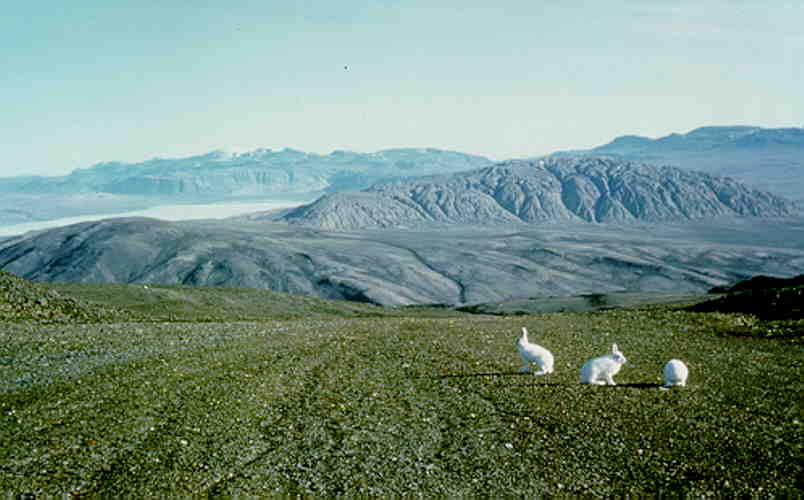
Arctic hares and
Mokka Fiord salt dome (with deep valleys; mountain 6 km across, 500 m high),
Eastern Axel Heiberg Island.
The barren
Arctic North as scenic in wildlife as an African savanna wild park? It can
be, in the pristine wilderness of
Northern Canada.
Canadian Arctic Islands
The dry
Arctic dessert has no obstructing vegetation as the vegetation all stays close
to the ground. Small juniper shrubs [1] grow horizontally
and grass grows mainly in sheltered valleys. Also, the cold, dry and clean air
gives an excellent visibility.
You can
easily spot the bigger wild animals.
Most are white, which is a camouflage colour among the white snow patches which
cover the area for 11 months per year. Only muskox are black like their distant
cousins from the ice-ages, the yaks. A mature, healthy adult muskox does not need a camouflage as it is no match
for the only big game hunter, wolves. Polar bears only hunt for seals.
Most
visible are the bigger mammals, small herds of muskox, lonely old muskox bulls,
cariboes, alone or in small groups, foxes and numerous white hares. Wolves are
less common as they need a large territory.
While
camping for 5 summer seasons of two months each in many different locations on
Axel Heiberg and Ellesmere Island in the eighties, I saw a lot of wild animals,
even the extremely rare ones like the mythical white falcons, the so-called
'Gyr Falcons'.
The best
area for spotting animals is at Buchanan lake on Eastern Axel Heiberg Island,
see picture above, the bay of Mokka Fiord in the far distance (behind the salt
dome). The few km wide flood plain between the sea at Mokka Fiord and
inaccessible mountain ranges is the only North-South corridor on Axel Heiberg
Island in the summer when the sea straits have no solid ice.
Birds are
more common in the colder areas close to the Arctic Ocean like on Western Axel
Heiberg Island as their are less prey animals like foxes and wolves.
Muskox
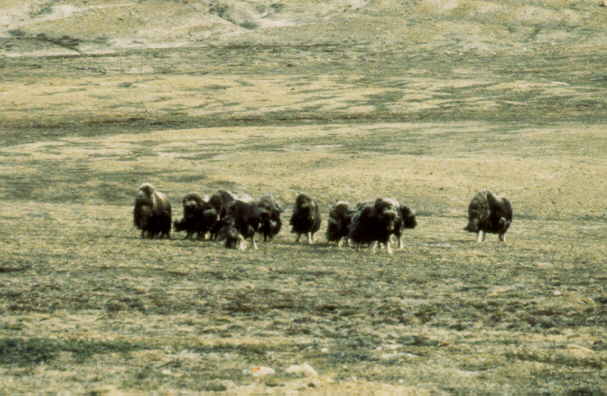
Muskox herd, on the defence
In most
valleys there is muskox herd consisting of a big dominant bull, 5-8 mature
females, 2-3 calfs and 4-5 adolescents, male and female. The number of mature
females seem to depends on the bulls managerial talents, the bigger the bull,
the more females.
Approaching a muskox herd
is not without risk. The herd forms a half-circle and the dominant bull stands
in front. You can approach them up to 200 meters, if they let you as they
usually already run off at a larger distance. When you get closer, the dominant
bull starts snoring and digging its hooves
into the ground you better leave if you do not want to be chased off or
even thrown in the air by its massive head and horns.
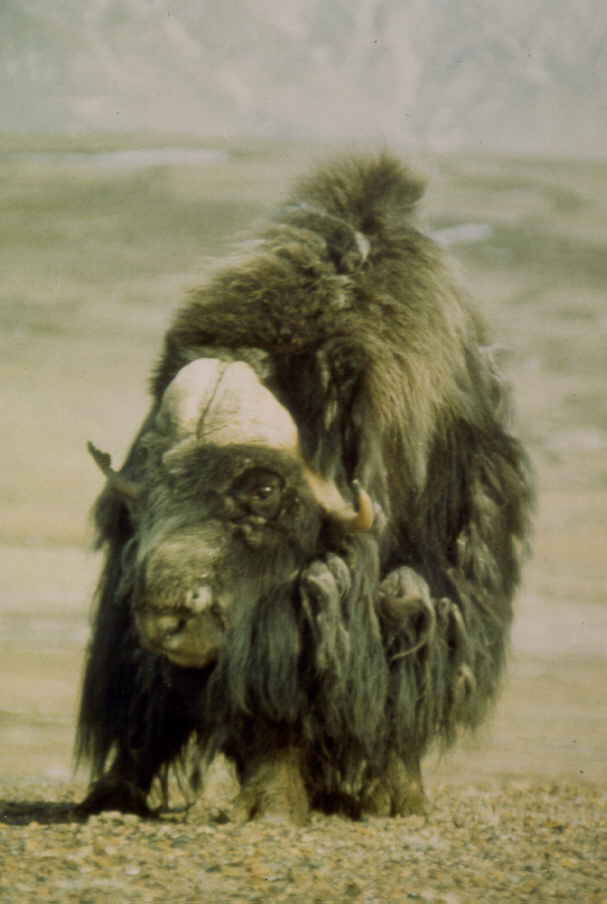
Muskox
bull.
Waking up
in the morning with a muskox herd [1] of 10-14 animals lying close to our tent
is a unique experience. At night the herd
may decide to seek shelter in one of their favorite, protected valleys
and happens to settled close to our tents. Our preferences are similar, we
always try to camp in a sheltered, grassy flat spot and preferably close to a
pond.
You can
take your time to observe them through a tent opening as they have poor
eye-sight. As soon as you get out of the tent, you loose the camouflage of the tents. They will spot
you and react in a panic as we have the size and movements of wolves in ambush.
They quickly run off at an impressive speed, preferably up-hill, just like
rabbits.
The
stampede led by the dominant bull lasts only a few minutes and they regroup
into a defensive half-circle higher up.
Lonely
bulls [1] can be approached closer, up to 50 meters.
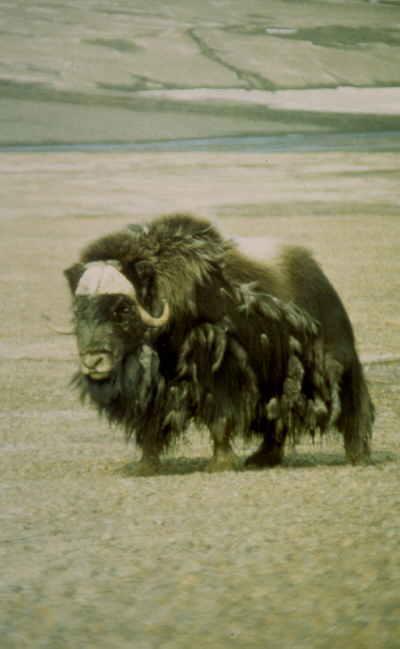
Fred,
the lonely muskox bull on Whitsunday Bay, Eastern Axel Heiberg Island.
Closer they
will first look at you, but at 20 m they will also starts snoring and digging
their hooves into the ground. Time to
quickly take the closest picture and leave unless you are a Canadian 'Jackass'
and want a picture being chased like Steve [1].
Skeletons
of muskox are common [1]. The tough skull and horns
preserves best [1].
A small heap in a sheltered valley with exceptionally high and healthy
grass tends to have a muskox skull in it core which serves as a fertilizer.
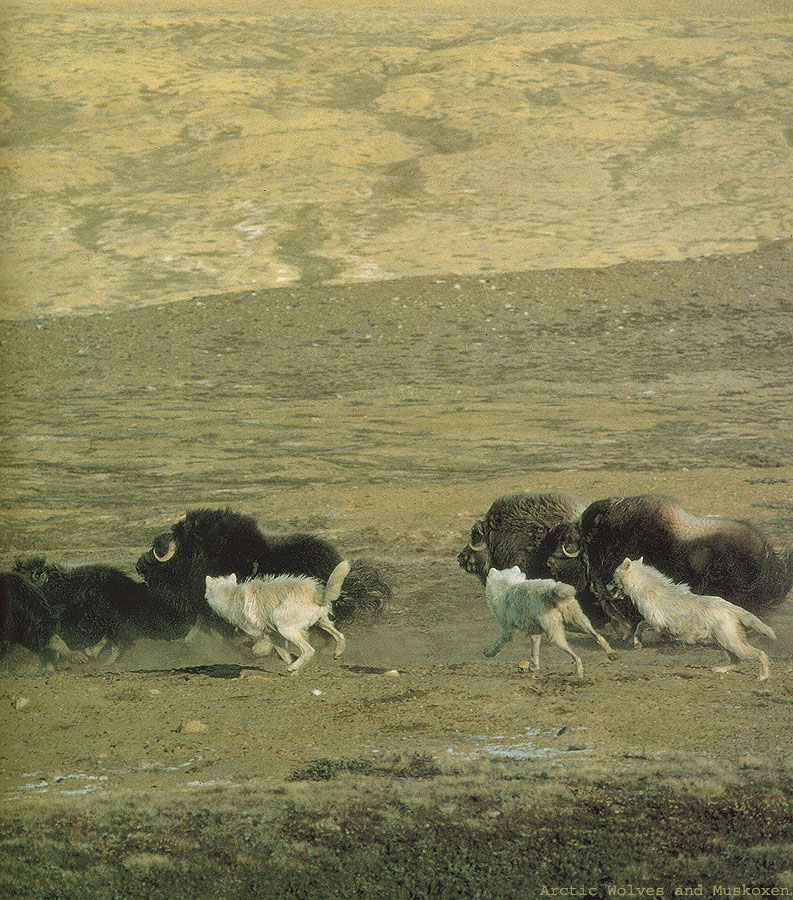
Arctic wolves chasing muskox. Photograph by Jim Brandenbug.
Polar Bears
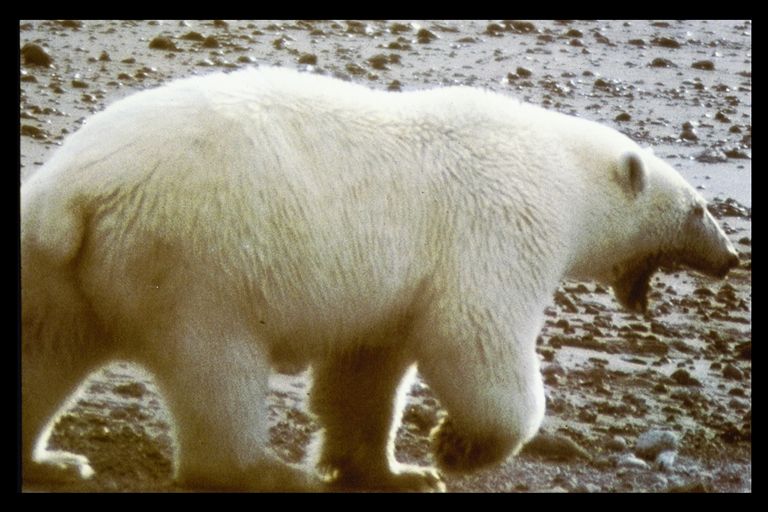
Polar Bear, photo courtesy Energy, Mines and Resources Canada
Polar bears are extremely rare in this area as the sea straits between the Arctic Island tends to be frozen until late July. Seals, the main staple of polar bears have to live near open water or keep a water hole in the ice so they are none except from mid July to September when the ice breaks up. In the early summer, during the ice-covered period until mid July, The only seals I saw before the ice break up was in the typical melt pools next to icebergs in the frozen Otto Fiord [1].
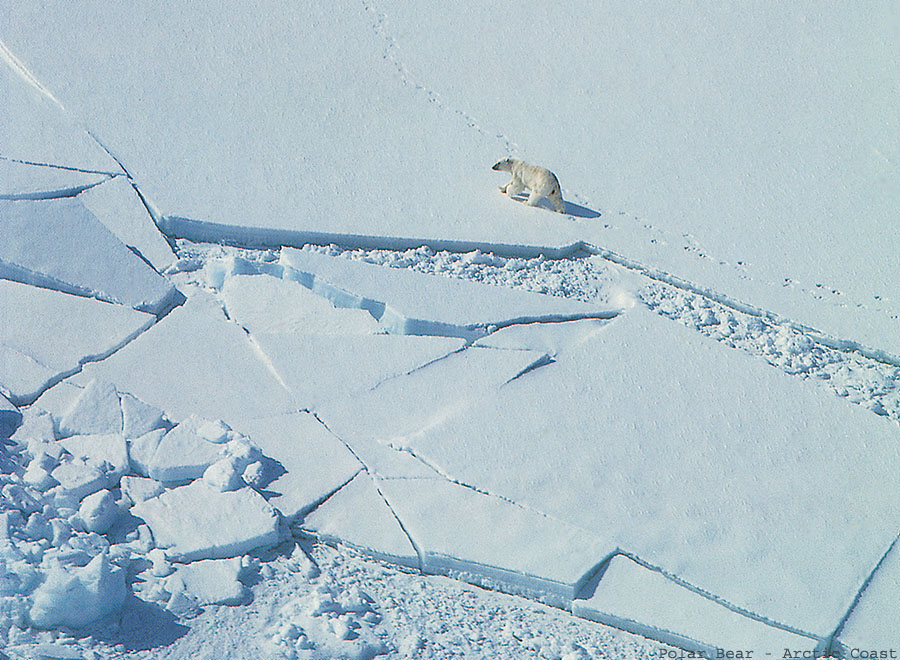
Polar bear. Photograph by Wolfgang Weber.

Polar bear. Photograph by Wolfgang Weber.
White Cariboe
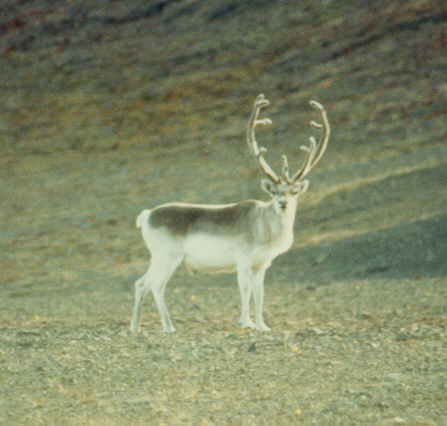
Male caribou
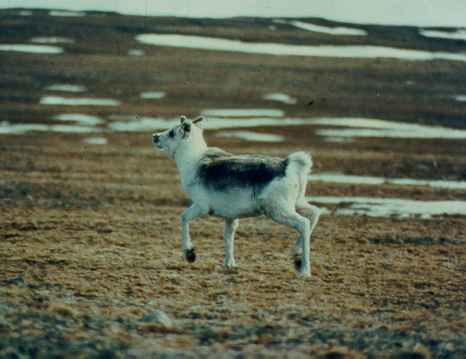
Female caribou, running
off after approaching us.
Cariboes walk around in
small groups of a few animals. They are curious animals, and approach us,
trying to make out our scent but do not recognize us.
Peary, the Arctic explorer
visiting this area around 1900 (who never reached the pole as he falsified his
log book), is said to have killed most
of the cariboes of this regions for fuel and food and they are said still to be
recovering
Arctic Hares
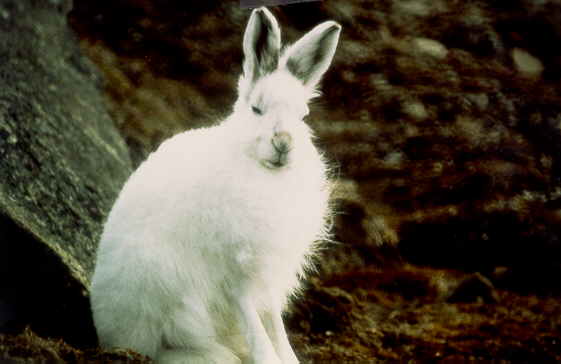
Mature Arctic hare
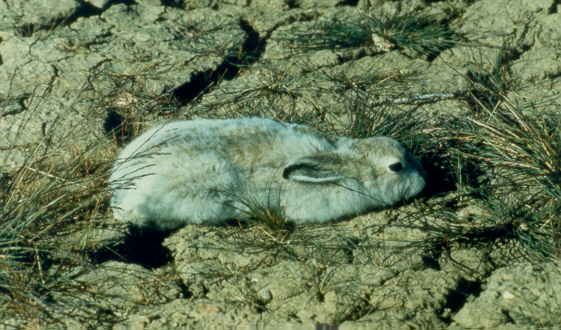
Young
Arctic hare, few weeks old, hiding relying on its camouflage color.
The white
Arctic Hares or 'bunnies' as we call them can be very common on the grassy
hills of Axel Heiberg Island. At times, hills with lots of grass are covered
with thousand of white dots.
In July,
young hares are born and these hide in sparse grass, trusting their earth brown
camouflage colour resembling the soil.
During the
warm period around the 13th century, Innuits of the Thule Culture had summer
hunting camps in this area for rabbits. There are still large semi circles of
stones [1] used for traps and smaller rings of stone
[1] used to hold down tents.
White Arctic Wolves

White Arctic wolf, picture of a third generation domesticated wolf in the Sierra Nevada.
White Arctic
wolves, see 1, are rare but very visible when
appearing. They are big, having the size of a Saint Bernard dog, twice the size
of a German Shepard, but with their long skinny legs look a lot smaller. They
show some interest in our camps but keep a large distance.
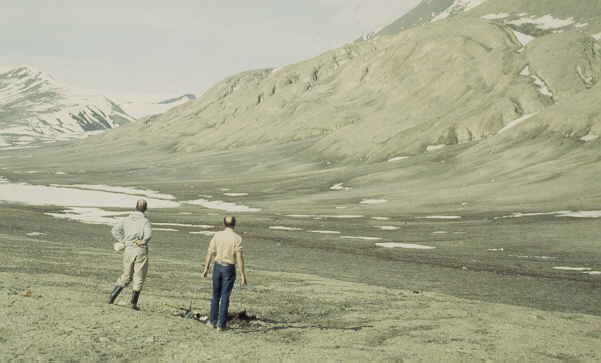
Looking at 5 white Arctic wolves at a km distance (white dots, not
visible), circling the camp for a few days.
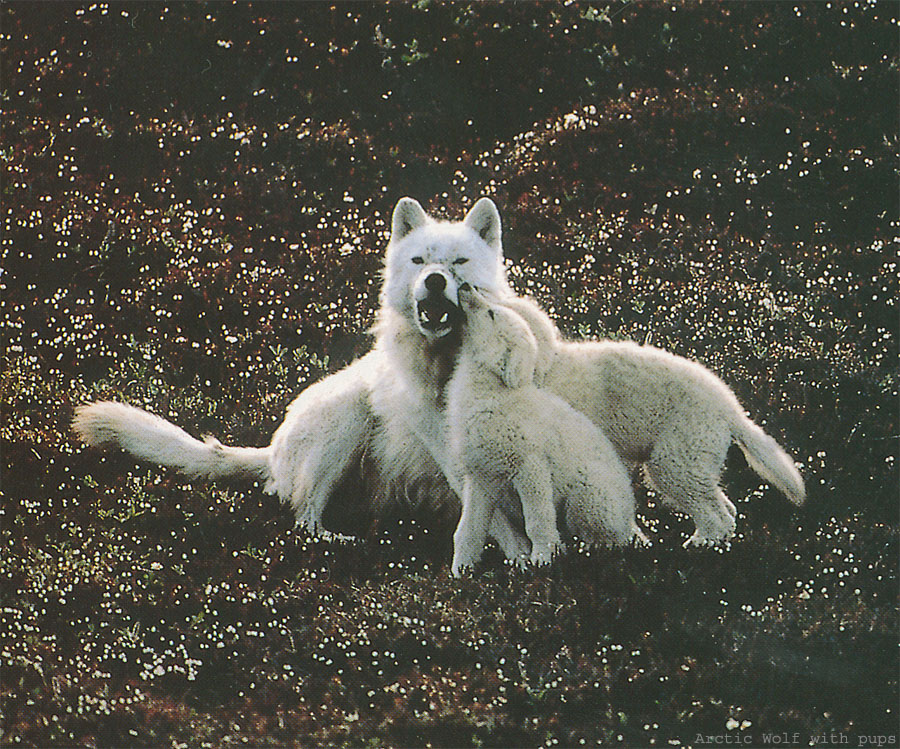
Arctic wolf with pups. Photograph by Jim Brandenbug.
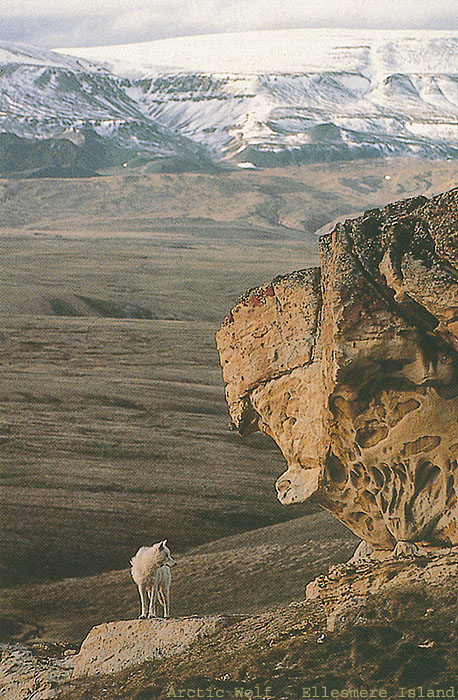
Arctic wolf. Photograph by Jim Brandenbug.
They will
only come close to investigate when you are out of the camp and have old smelly
garbage. On one occasion, they took the 'back-door' ripping a tent and
scattering 4 week old garbage around.
Foxes
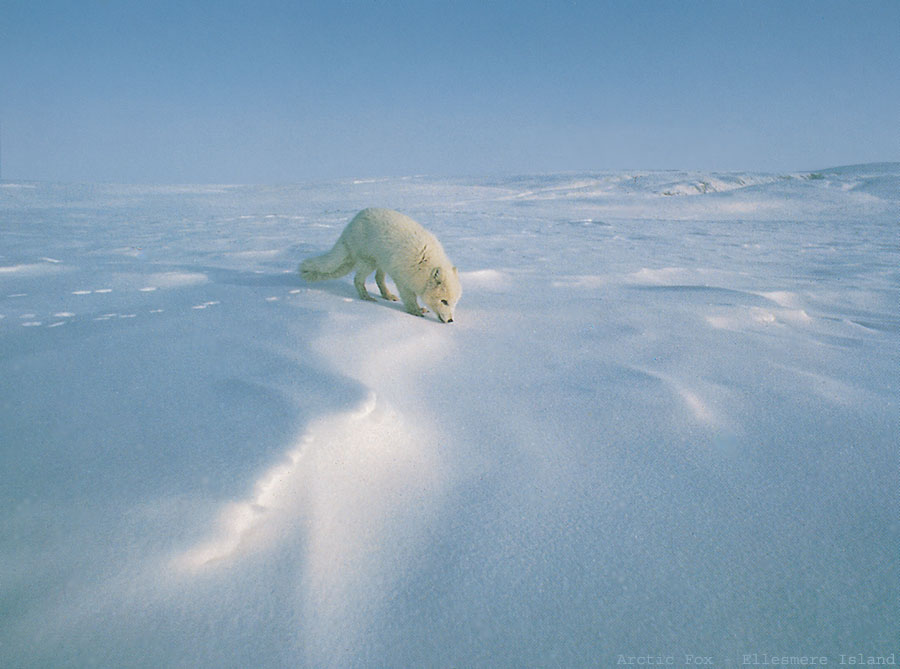
Arctic fox. Photograph by Jim Brandenbug.
Many valleys have a fox living there and they tend to
snoop around carefully so you often do not notice them. They hunt for lemmings
and look for birds eggs.
Lemmings
Lemmings
resemble small hamsters and can be very common, especially when the snow cover
stays for a long time giving them places to hide by digging tunnels in the
snow.
1989 was
not only the year of heavy snow but also a lemming year. On snow free areas,
almost every rock had a lemming hiding
underneath.
When you
catch a lemming, it will shit in trying to free itself. You better wear a glove
like Jeffy below.
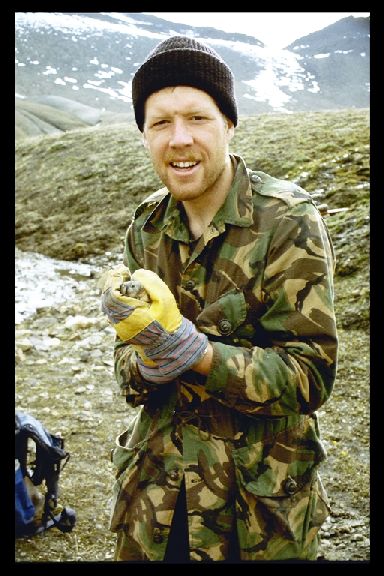
Jeffy with
lemming, shitting in his glove. Eastern Axel Heiberg Island, 1984.
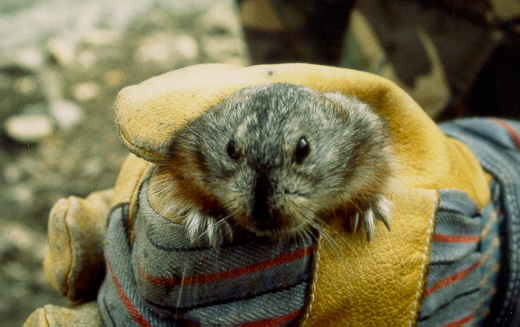
Detail
Birds
Birds are
very common despite lack of save nesting areas.
Most common
are snow buntings, Jagers, snow geese and tarmagons.
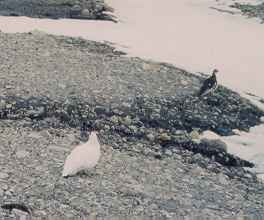
Tarmagons
I saw snowy
owls and Gyr falcons only in an isolated area on Western Axel Heiberg Island.
Here, we found a nest with young snow owls and a nest with white Geier Falcons.
The latter are extremely rare birds. Rich Arabs pay a fortune to acquire a
Geier Falcon and they are known to be smuggled out of Siberia.

Nest with young snow
owls.
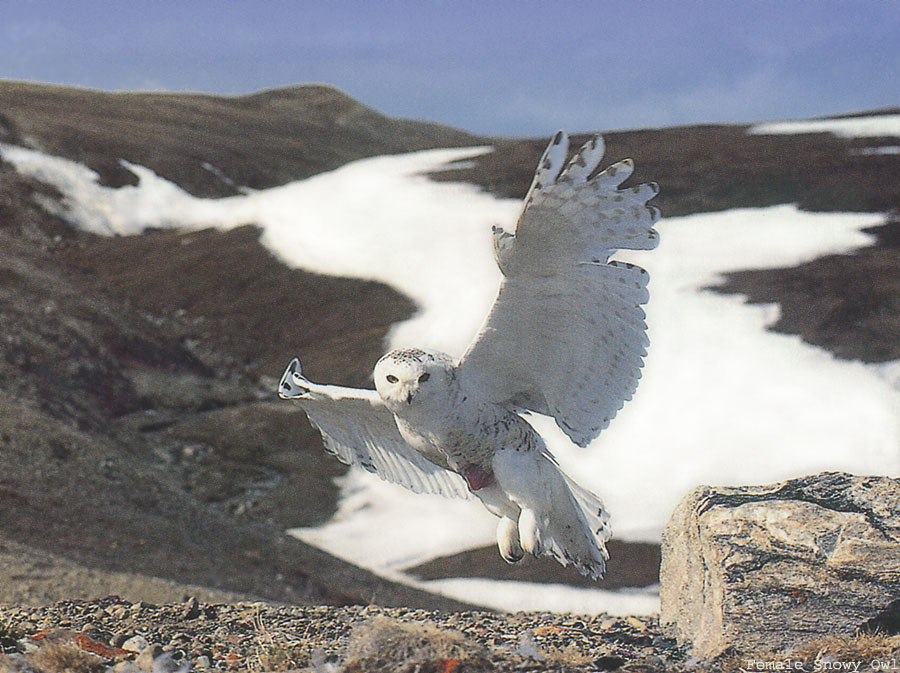
Snowy owl. Photograph by Brian Hawkes..
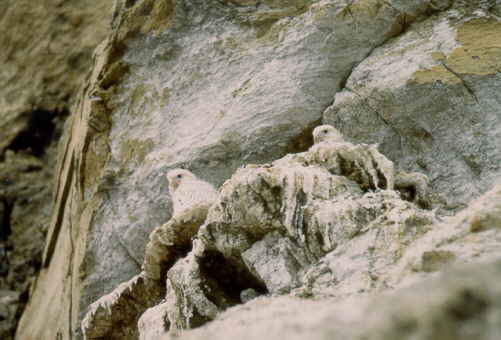
Nest with young Gyr
falcons.
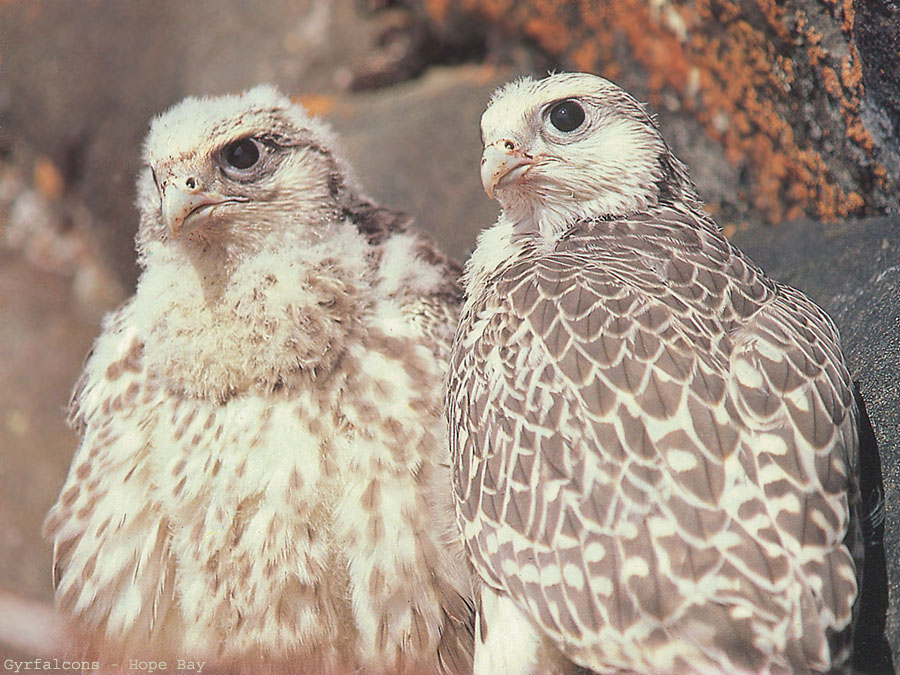
Gyr falcons. Photograph by Kim Poole..
Arctic Char
Arctic Char
resemble salmons, their meat is also pink but is very soft, similar to trout.
They live in fresh water lakes near the coast and go to the sea for feeding, as
the cold Arctic seas are very rich in food but the shallow lakes have very
little food.
We tried
fishing for Arctic Char in the giant Buchanan Lake on Western Axel Heiberg
Island but they failed to bite. A geological hammer proved to be more efficient
as we managed to hammer one down in the shallow braided stream between the lake
and the sea while it was resting unsuspicious of any danger.
Beluga Whales
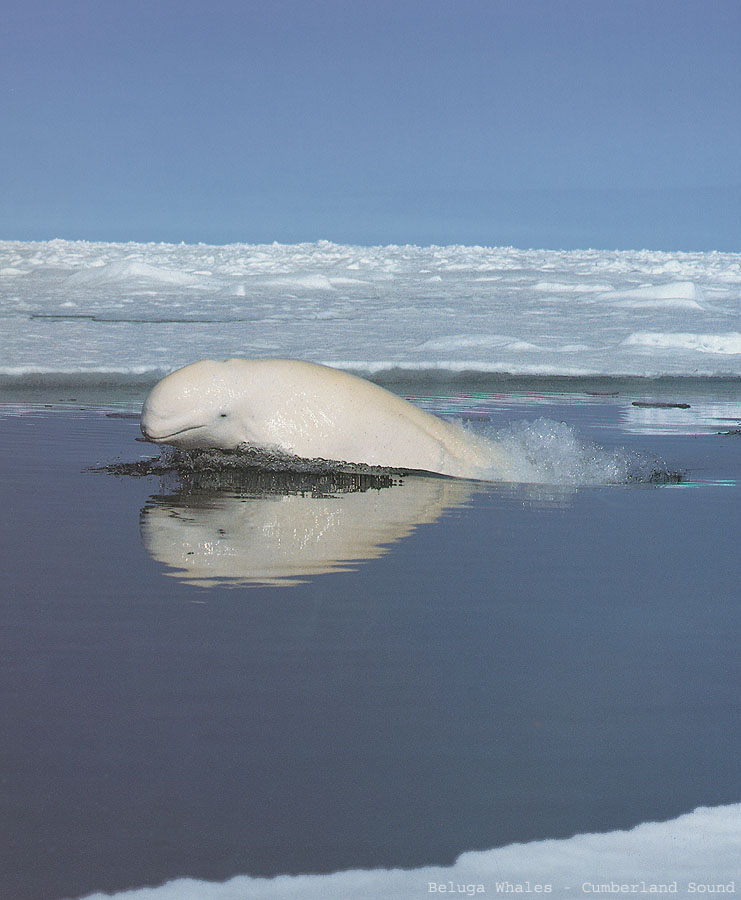
Beluga whales. Photograph by John Ford..
I saw Beluga whales only once out of a Twin Otter plane flying from Ellesmere to Resolute Bay at 4 AM. The pilot made a few loops so we could watch them.
Epiloque
This area
is rarely visited by tourist and given the fragile nature it better remain so. E.g.
a footstep in the muddy toundra will stay for tens of years. Moss and plants
may need a 100 years to come back.
A Twin
Otter plane could take you to the Lake Hazen National Park on Northern
Ellesmere Island. Russian ice breakers also do a trip from Resolute Bay to
Tanquary Fiord, South of lake Hazen,
through Eureka [1].
Prices are
high, count on $10000 for the boat and $15000 for the plane, for 2-3 weeks
only.
Narwhals. After[1].
Narwhal tusk, 1.30 m tall. Carved by Baffin Island Inuits
Also see a unique BBC documentary from 10 February 2009 on narwhals, click on [1]Narwhal (narwal) pictures by Paul Nicklen, also see [1]
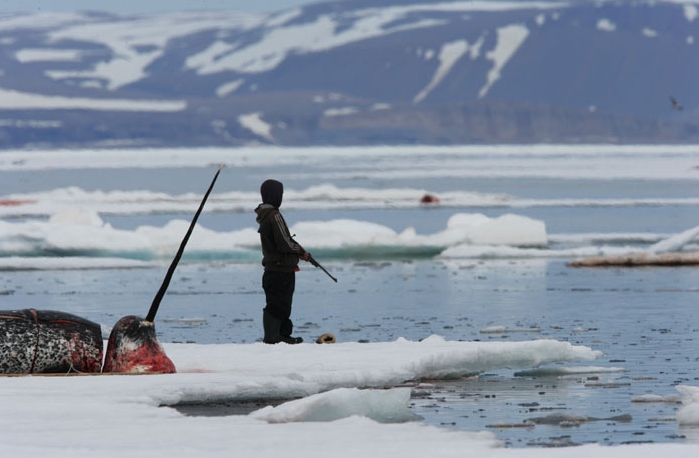
Shot
Narwhal with hunter waiting for passing Narwhals
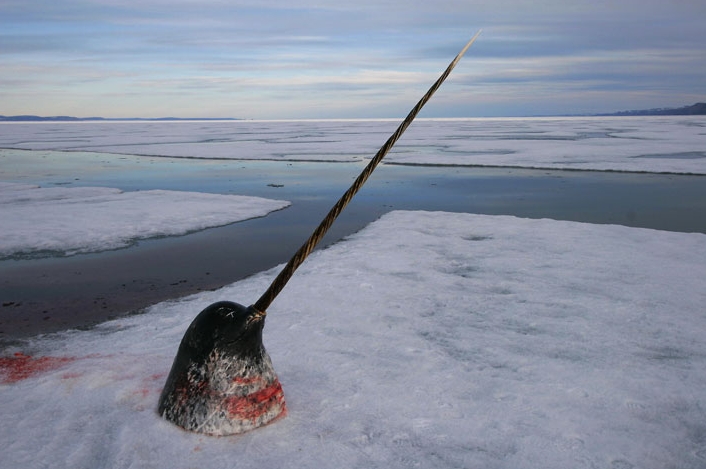
Narwhal
head and tusk. Also
on World Press Photo 2008, bottom
More on Narwhals, habitat in Canada, etc.: After Fisheries and Oceans Canada
